Heat Transfer and Temperature Characteristics of a Working Digital Camera
Abstract
1. Introduction
2. Model for Heat Transfer Process of Working Digital Camera Systems
2.1. Temperature Distribution of Working Typical Camera Systems
2.2. Temperature Model of Working Digital Camera System
2.3. Experimental Verification
3. Temperature Variation and Distribution
3.1. Influence of Thermal Parameters
3.2. Influence of Environmental Temperature
4. Conclusions
Author Contributions
Funding
Conflicts of Interest
References
- Liu, X.S.; Zhao, W.; Xiong, L.L.; Liu, H. Thermal design and management in high power semiconductor laser packaging. In Packaging of High Power Semiconductor Lasers; Suhir, E., Ed.; Springer: New York, NY, USA, 2015; pp. 53–88. [Google Scholar]
- Ohring, M.; Kasprzak, L. Reliability and Failure of Electronic Material and Devices, 2nd ed.; Academic Press: New York, NY, USA, 2011. [Google Scholar]
- Hsu, Y.S.; Wang, L.K.; Liu, W.F.; Chiang, Y.J. Temperature compensation of optical fiber bragg grating pressure sensor. IEEE Photon. Technol. Lett. 2006, 18, 874–876. [Google Scholar] [CrossRef]
- Lehtonen, T.A.; Hallstrom, J. Optimizing temperature coefficient and frequency response of rogowski coils. IEEE Sens. J. 2017, 17, 6646–6652. [Google Scholar] [CrossRef]
- Liu, Y.; Zhou, Z.D.; Zhang, E.L.; Zhang, J.; Tan, Y.G.; Liu, M.Y. Measurement error of surface-mounted fiber bragg grating temperature sensor. Rev. Sci. Instrum. 2014, 85, 064905. [Google Scholar]
- Pearce, E.M. Thermal Characterization of Polymeric Materials, 2nd ed.; Academic Press: New York, NY, USA, 2000. [Google Scholar]
- Sundar, L.S.; Singh, M.K.; Ferro, M.C.; Sousa, A.C.M. Experimental investigation of the thermal transport properties of graphene oxide/Co3O4 hybrid nanofluids. Int. Commun. Heat Mass 2017, 84, 1–10. [Google Scholar] [CrossRef]
- Zhao, H.; Liu, F.Q.; Yang, H. Thermal properties of coarse RCA concrete at elevated temperatures. Appl. Therm. Eng. 2018, 140, 180–189. [Google Scholar] [CrossRef]
- Chiu, Y.J.; Yan, W.M.; Chiu, H.C.; Jang, J.H.; Ling, G.Y. Investigation on the thermophysical properties and transient heat transfer characteristics of composite phase change materials. Int. Commun. Heat Mass 2018, 98, 223–231. [Google Scholar] [CrossRef]
- Zhao, S.Y.; Sun, X.Y.; Li, Z.Y.; Xie, W.H.; Meng, S.H.; Wang, C.; Zhang, W.J. Simultaneous retrieval of high temperature thermal conductivities, anisotropic radiative properties, and thermal contact resistance for ceramic foams. Appl. Therm. Eng. 2019, 146, 569–576. [Google Scholar] [CrossRef]
- Vishwakarma, V.; Waghela, C.; Jain, A. Measurement of out-of-plane thermal conductivity of substrates for flexible electronics and displays. Microelectron. Eng. 2015, 142, 36–39. [Google Scholar] [CrossRef]
- Jain, A.; Goodson, K.E. Measurement of the thermal conductivity and heat capacity of freestanding shape memory thin films using the 3ω method. J. Heat Trans.-T ASME 2008, 130, 102402. [Google Scholar] [CrossRef]
- Bejan, A.; Tsatsaronis, G.; Moran, M. Thermal Design and Optimization, 1st ed.; Wiley-Interscience: New York, NY, USA, 1995. [Google Scholar]
- Meng, H.H.; Sun, L.X.; Zhang, C.Q.; Geng, L.Y. Thermal design and flight validation for high precision camera. In Proceedings of the AOPC 2015: Telescope and Space Optical Instrumentation, Beijing, China, 5–7 May 2015. [Google Scholar]
- Al-Neama, A.F.; Kapur, N.; Summers, J.; Thompson, H.M. Thermal management of GaN HEMT devices using serpentine minichannel heat sinks. Appl. Therm. Eng. 2018, 140, 622–636. [Google Scholar] [CrossRef]
- Ahmed, H.E.; Ahmed, M.I. Optimum thermal design of triangular, trapezoidal and rectangular grooved microchannel heat sinks. Int. Commun. Heat Mass 2015, 66, 47–57. [Google Scholar] [CrossRef]
- Poussier, S.; Rabah, H.; Weber, S. Adaptable thermal compensation system for strain gage sensors based on programmable chip. Sens. Actuat. A-Phys. 2005, 119, 412–417. [Google Scholar] [CrossRef]
- Pan, B. Thermal error analysis and compensation for digital image/volume correlation. Opt. Lasers Eng. 2018, 101, 1–15. [Google Scholar] [CrossRef]
- Jiji, L.M. Heat Conduction, 3rd ed.; Springer: Berlin/Heidelberg, Germany, 2009. [Google Scholar]
- Liu, W.Y.; Ding, Y.L.; Wu, Q.W.; Jia, J.Q.; Guo, L.; Wang, L.H. Thermal analysis and design of the aerial camera’s primary optical system components. Appl. Therm. Eng. 2012, 38, 40–47. [Google Scholar] [CrossRef]
- Wang, X.; Jiang, H.Q. Design of origami for heat dissipation enhancement. Appl. Therm. Eng. 2018, 145, 674–684. [Google Scholar] [CrossRef]
- Sharpe, W.N. Handbook of Experimental Solid Mechanics, 1st ed.; Springer: New York, NY, USA, 2008. [Google Scholar]
- Ma, Q.W.; Ma, S.P. Experimental investigation of the systematic error on photomechanics methods induced by camera self-heating. Opt. Express. 2013, 21, 7686. [Google Scholar] [CrossRef] [PubMed]
- Adamczyk, M.; Liberadzki, P.; Sitnik, R. Temperature compensation method for digital cameras in 2D and 3D measurement applications. Sensors 2018, 18, 3685. [Google Scholar] [CrossRef] [PubMed]
- Ma, S.P.; Zhou, S.C.; Ma, Q.W. Image distortion of working digital camera induced by environmental temperature and camera self-heating. Opt. Lasers Eng. 2019, 115, 67–73. [Google Scholar] [CrossRef]
- Handel, H. Analysis the influences of camera warm-up effects on image acquisition. IPSJ Trans. Comput. Vis. 2009, 1, 12–20. [Google Scholar] [CrossRef]
- Handel, H. Analyzing the influence of camera temperature on the image acquisition process. In Proceedings of the Three-Dimensional Image Capture and Applications 2008, San Jose, CA, USA, 27–31 January 2008. [Google Scholar]
- Ma, S.P.; Pang, J.Z.; Ma, Q.W. The systematic error in digital image correlation induced by self-heating of a digital camera. Meas. Sci. Technol. 2012, 23, 025403. [Google Scholar] [CrossRef]
- Pan, B.; Shi, W.; Lubineau, G. effect of camera temperature variation on stereo-digital image correlation measurements. Appl. Opt. 2015, 54, 10089–10095. [Google Scholar] [CrossRef]
- Zhou, H.F.; Zheng, J.F.; Xie, Z.L.; Lu, L.J.; Ni, Y.Q.; Ko, J.M. Temperature effects on vision measurement system in long-term continuous monitoring of displacement. Renew. Energy 2017, 114, 968–983. [Google Scholar] [CrossRef]
- Dauvin, L.; Drass, H.; Vanzi, L. Optimization of temperature, targets, and illumination for high precision photogrammetric measurements. IEEE Sens. J. 2018, 18, 1449–1456. [Google Scholar] [CrossRef]
- Handel, H. Compensation of thermal errors in vision based measurement systems using a system identification approach. In Proceedings of the 2008 9th International Conference on Signal Processing, Beijing, China, 26–29 October 2008; pp. 1329–1333. [Google Scholar]
- Yu, Q.F.; Chao, Z.C.; Jiang, G.W. The effects of temperature variation on videometric measurement and a compensation method. Image Vis. Comput. 2014, 32, 1021–1029. [Google Scholar] [CrossRef]
- Pan, B.; Yu, L.P.; Wu, D.F. High-accuracy 2D digital image correlation measurements using low-cost imaging lenses: Implementation of a generalized compensation method. Meas. Sci. Technol. 2014, 25, 025001. [Google Scholar] [CrossRef]
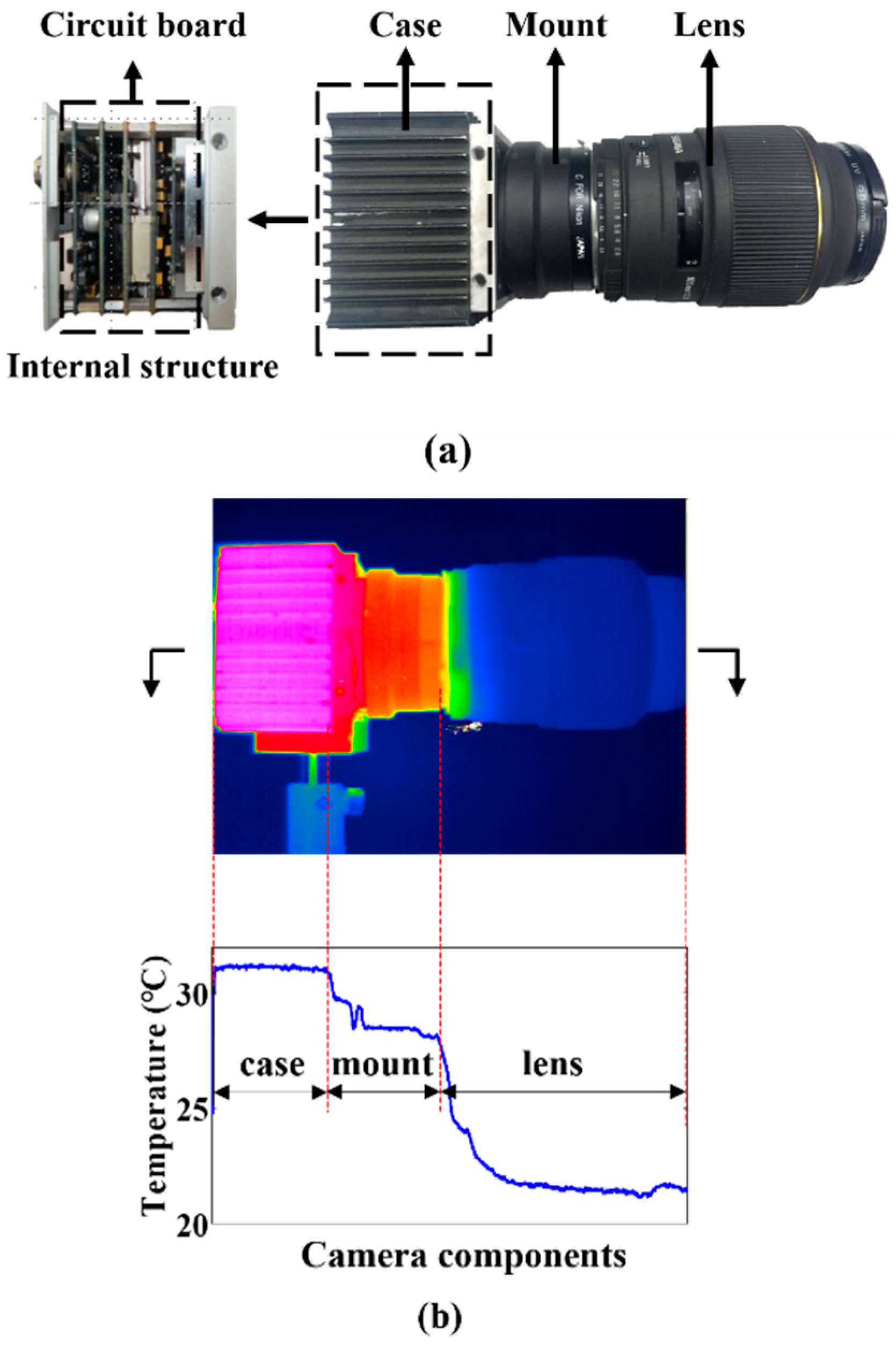
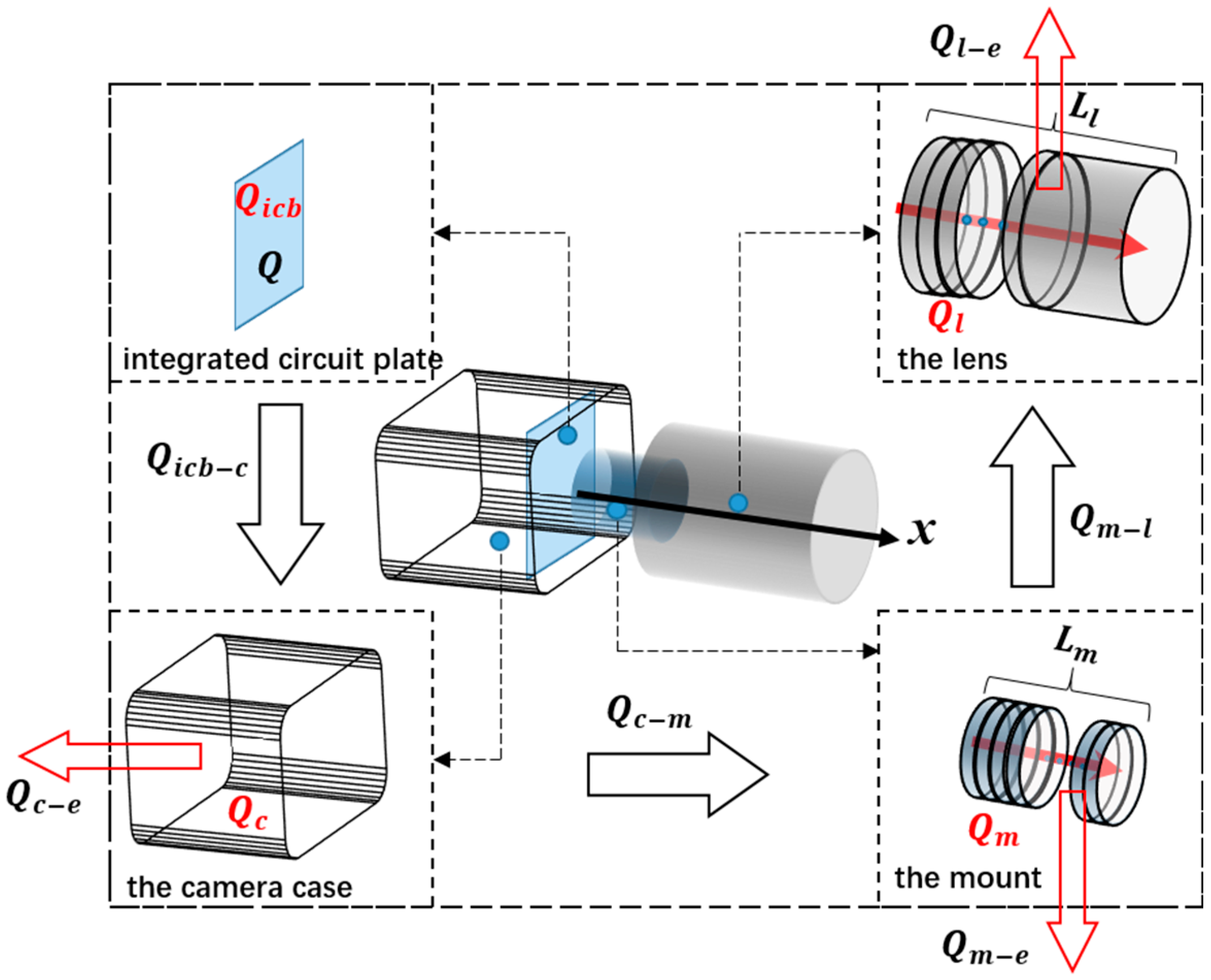

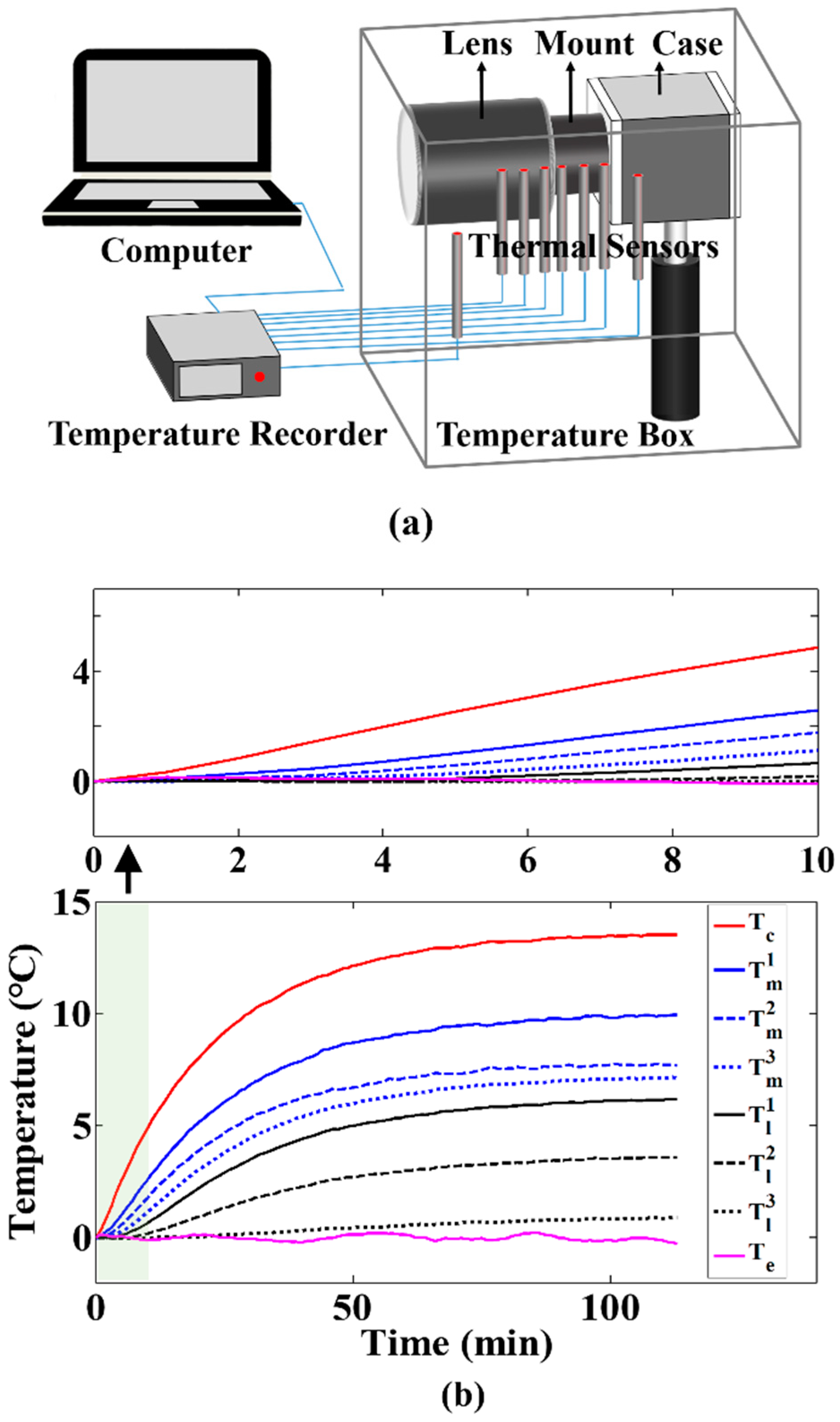


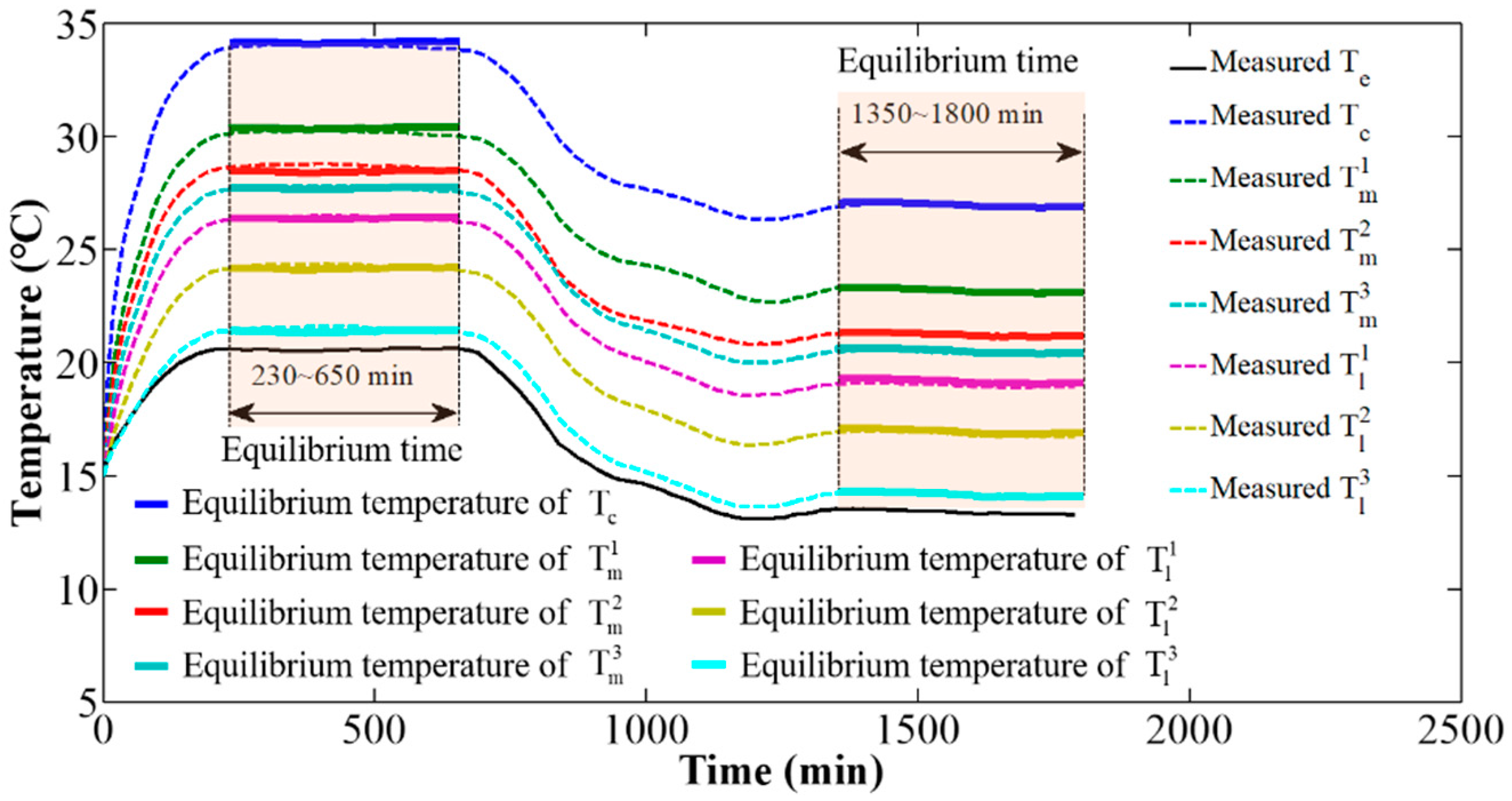

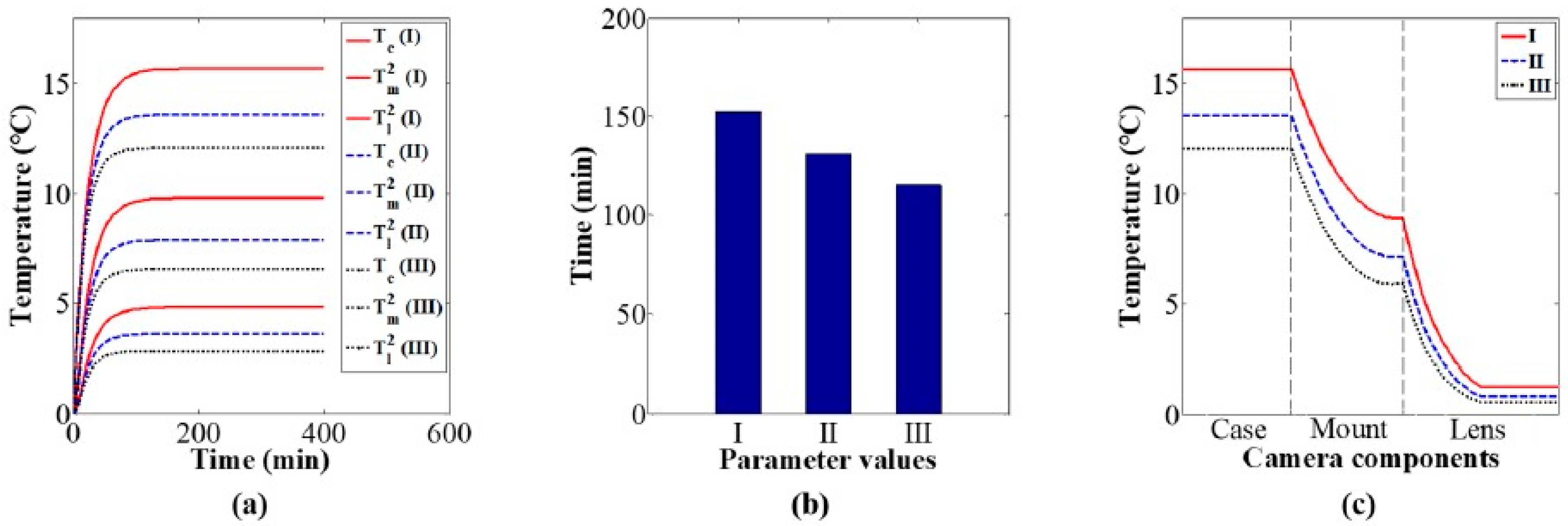

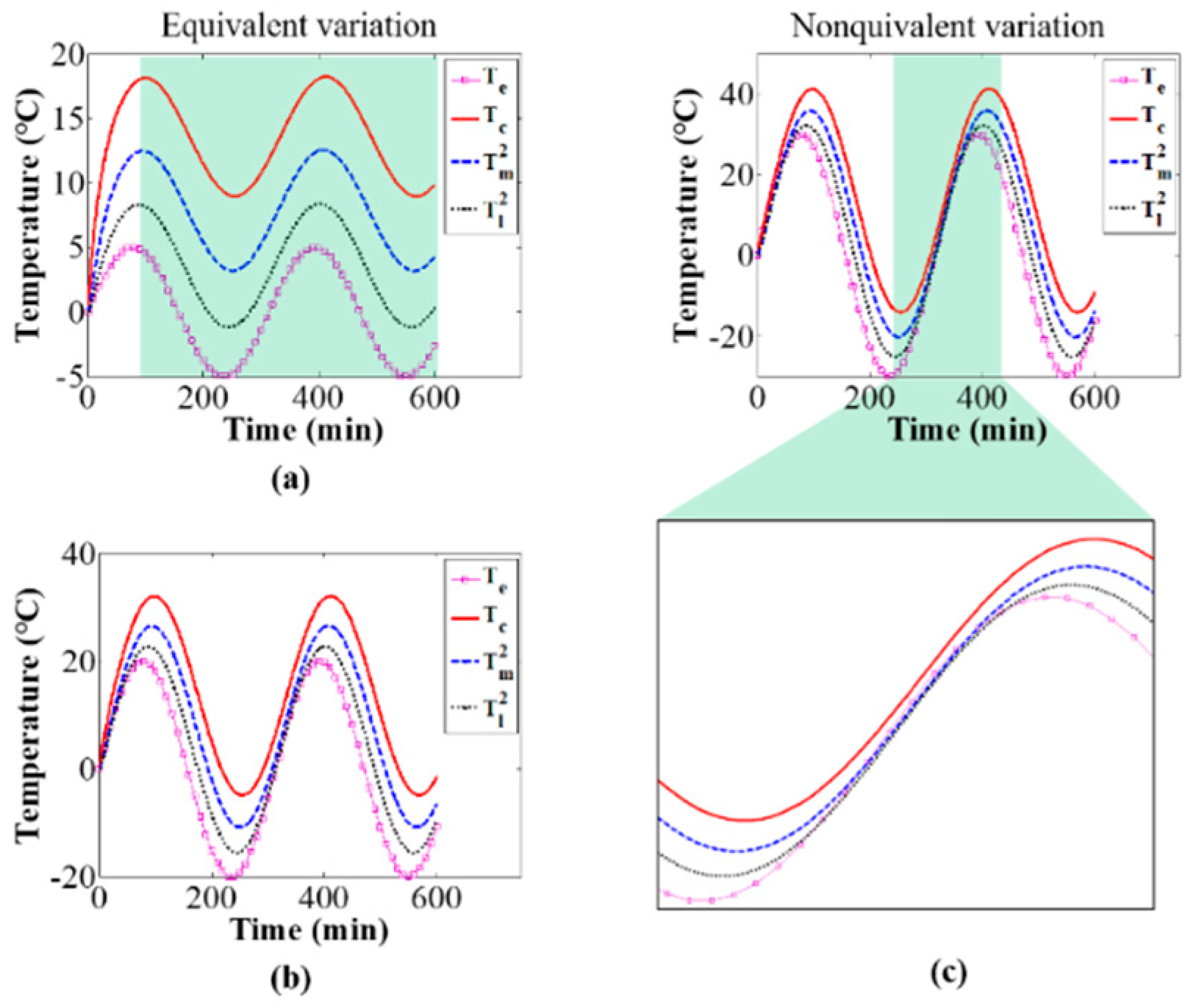



| Parameter | r1 | r2 | r3 | r4 | r5 | r6 | k1 | k2 | k3 | k4 |
|---|---|---|---|---|---|---|---|---|---|---|
| value | 0.21 | 0.03 | 0.09 | 0.06 | 0.03 | 0.21 | 0.76 | 0.17 | 0.97 | 0.87 |
| Parameter | km | mm |
|---|---|---|
| value | 143.80 | 0.13 |
| Parameter | kl | ml |
|---|---|---|
| value | 116.41 | 0.55 |
| Parameter | r1 | r3 | r5 | km | kl |
|---|---|---|---|---|---|
| I | 0.17 | 0.07 | 0.02 | 115.04 | 93.13 |
| II | 0.21 | 0.09 | 0.03 | 143.80 | 116.41 |
| III | 0.25 | 0.11 | 0.04 | 172.56 | 139.69 |
| Parameter | r2 | r4 | r6 | mm | ml |
|---|---|---|---|---|---|
| I | 0.02 | 0.05 | 0.17 | 0.10 | 0.44 |
| II | 0.03 | 0.06 | 0.21 | 0.13 | 0.55 |
| III | 0.04 | 0.07 | 0.25 | 0.16 | 0.66 |
| Parameter | k1 | k2 | k3 | k4 | nm | nl |
|---|---|---|---|---|---|---|
| I | 0.61 | 0.14 | 0.78 | 0.70 | 0.80 | 0.80 |
| II | 0.76 | 0.17 | 0.97 | 0.87 | 1.00 | 1.00 |
| III | 0.91 | 0.20 | 1.16 | 1.04 | 1.20 | 1.20 |
© 2020 by the authors. Licensee MDPI, Basel, Switzerland. This article is an open access article distributed under the terms and conditions of the Creative Commons Attribution (CC BY) license (http://creativecommons.org/licenses/by/4.0/).
Share and Cite
Zhou, S.; Zhu, H.; Ma, Q.; Ma, S. Heat Transfer and Temperature Characteristics of a Working Digital Camera. Sensors 2020, 20, 2561. https://doi.org/10.3390/s20092561
Zhou S, Zhu H, Ma Q, Ma S. Heat Transfer and Temperature Characteristics of a Working Digital Camera. Sensors. 2020; 20(9):2561. https://doi.org/10.3390/s20092561
Chicago/Turabian StyleZhou, Shichao, Haibin Zhu, Qinwei Ma, and Shaopeng Ma. 2020. "Heat Transfer and Temperature Characteristics of a Working Digital Camera" Sensors 20, no. 9: 2561. https://doi.org/10.3390/s20092561
APA StyleZhou, S., Zhu, H., Ma, Q., & Ma, S. (2020). Heat Transfer and Temperature Characteristics of a Working Digital Camera. Sensors, 20(9), 2561. https://doi.org/10.3390/s20092561





